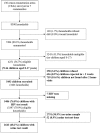Community burden of undiagnosed HIV infection among adolescents in Zimbabwe following primary healthcare-based provider-initiated HIV testing and counselling: A cross-sectional survey
- PMID: 28742829
- PMCID: PMC5526522
- DOI: 10.1371/journal.pmed.1002360
Community burden of undiagnosed HIV infection among adolescents in Zimbabwe following primary healthcare-based provider-initiated HIV testing and counselling: A cross-sectional survey
Abstract
Background: Children living with HIV who are not diagnosed in infancy often remain undiagnosed until they present with advanced disease. Provider-initiated testing and counselling (PITC) in health facilities is recommended for high-HIV-prevalence settings, but it is unclear whether this approach is sufficient to achieve universal coverage of HIV testing. We aimed to investigate the change in community burden of undiagnosed HIV infection among older children and adolescents following implementation of PITC in Harare, Zimbabwe.
Methods and findings: Over the course of 2 years (January 2013-January 2015), 7 primary health clinics (PHCs) in southwestern Harare implemented optimised, opt-out PITC for all attendees aged 6-15 years. In February 2015-December 2015, we conducted a representative cross-sectional survey of 8-17-year-olds living in the 7 communities served by the study PHCs, who would have had 2 years of exposure to PITC. Knowledge of HIV status was ascertained through a caregiver questionnaire, and anonymised HIV testing was carried out using oral mucosal transudate (OMT) tests. After 1 participant taking antiretroviral therapy was observed to have a false negative OMT result, from July 2015 urine samples were obtained from all participants providing OMTs and tested for antiretroviral drugs to confirm HIV status. Children who tested positive through PITC were identified from among survey participants using gender, birthdate, and location. Of 7,146 children in 4,251 eligible households, 5,486 (76.8%) children in 3,397 households agreed to participate in the survey, and 141 were HIV positive. HIV prevalence was 2.6% (95% CI 2.2%-3.1%), and over a third of participants with HIV were undiagnosed (37.7%; 95% CI 29.8%-46.2%). Similarly, among the subsample of 2,643 (48.2%) participants with a urine test result, 34.7% of those living with HIV were undiagnosed (95% CI 23.5%-47.9%). Based on extrapolation from the survey sample to the community, we estimated that PITC over 2 years identified between 18% and 42% of previously undiagnosed children in the community. The main limitation is that prevalence of undiagnosed HIV was defined using a combination of 3 measures (OMT, self-report, and urine test), none of which were perfect.
Conclusions: Facility-based approaches are inadequate in achieving universal coverage of HIV testing among older children and adolescents. Alternative, community-based approaches are required to meet the Joint United Nations Programme on HIV/AIDS (UNAIDS) target of diagnosing 90% of those living with HIV by 2020 in this age group.
Conflict of interest statement
The authors have declared that no competing interests exist.
References
-
- UNAIDS. Children and HIV. Geneva: UNAIDS, 2016. Available from: http://www.unaids.org/sites/default/files/media_asset/FactSheet_Children... Accessed 10 January 2017.
-
- UNAIDS. Global AIDS Update. 2016. Available from: http://www.unaids.org/sites/default/files/media_asset/global-AIDS-update... Accessed 10 January 2017
-
- UNAIDS. On the Fast-track to an AIDS-Free Generation. 2016. Available from: http://www.unaids.org/en/resources/documents/2016/GlobalPlan2016 Accessed 19 April 2017
-
- Ferrand RA, Corbett EL, Wood R, Hargrove J, Ndhlovu CE, Cowan FM, et al. AIDS among older children and adolescents in Southern Africa: projecting the time course and magnitude of the epidemic. AIDS. 2009;23(15):2039–46. doi: 10.1097/QAD.0b013e32833016ce - DOI - PMC - PubMed
-
- Mokgatle MM, Madiba S. The burden of disease on HIV-infected orphaned and non-orphaned children accessing primary health facilities in a rural district with poor resources in South Africa: a cross-sectional survey of primary caregivers of HIV-infected children aged 5–18 years. Infect Dis Poverty. 2015;4:18 doi: 10.1186/s40249-015-0049-x - DOI - PMC - PubMed
MeSH terms
Grants and funding
LinkOut - more resources
Full Text Sources
Other Literature Sources
Medical


